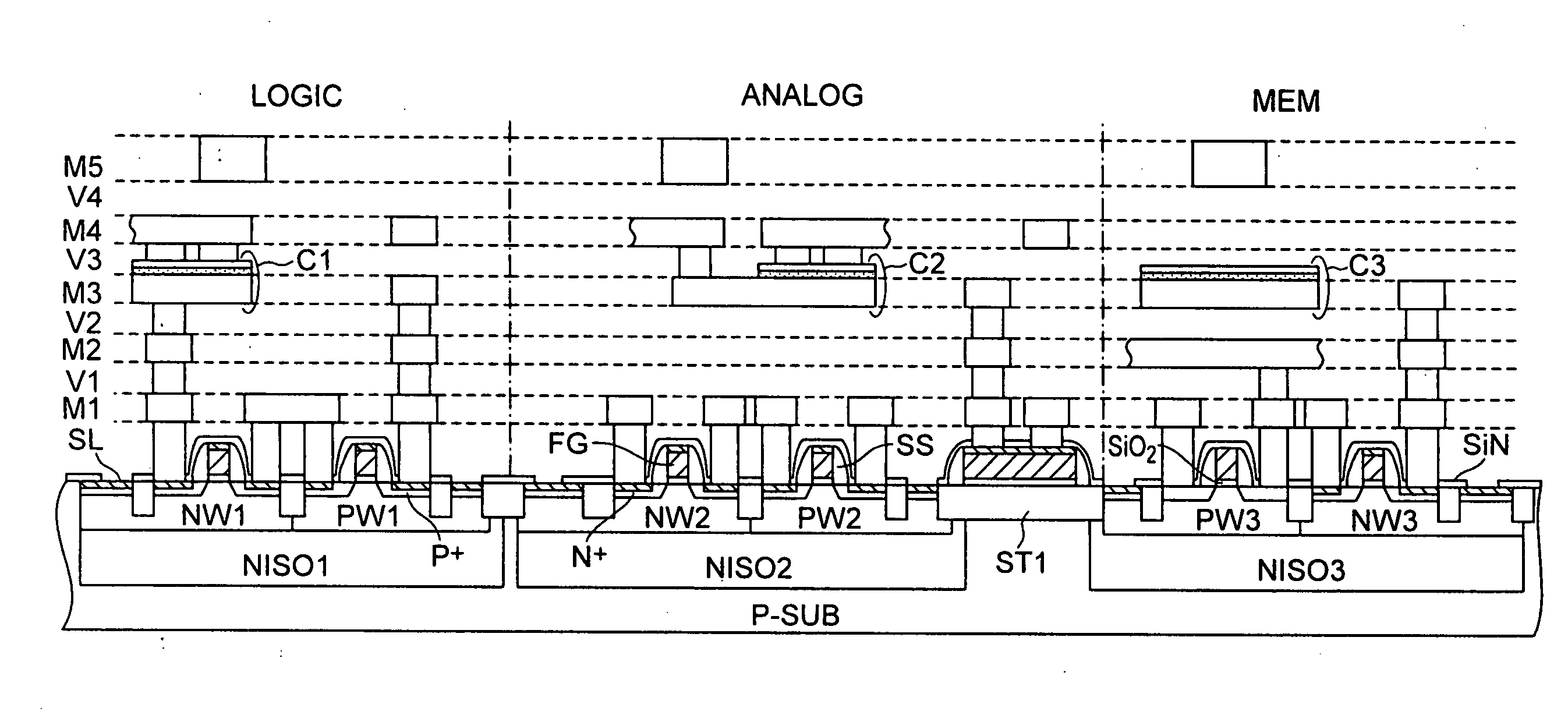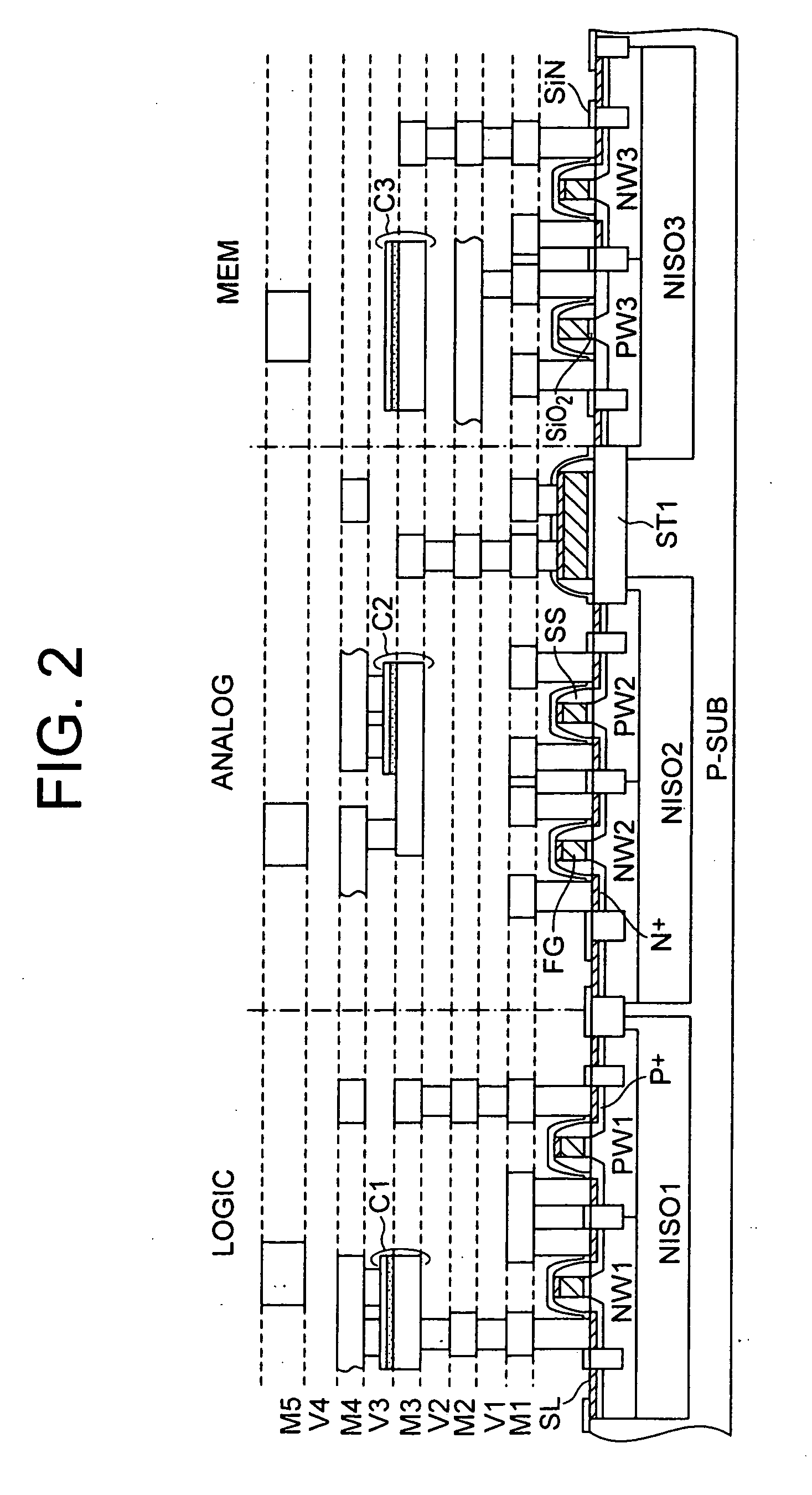Semiconductor device having plural dram memory cells and a logic circuit and method for manufacturing the same
a memory cell and semiconductor technology, applied in semiconductor devices, semiconductor/solid-state device details, electrical apparatus, etc., can solve the problems of limited capacity of memory mountable on one lsi chip, high cost, and first issue considered problematic, and achieve low cost, low voltage, and ultra-high integration
- Summary
- Abstract
- Description
- Claims
- Application Information
AI Technical Summary
Benefits of technology
Problems solved by technology
Method used
Image
Examples
first embodiment
[0058]FIG. 1 is a diagram showing a semiconductor integrated circuit LSI (referred to as “LSI” hereinafter) which is one embodiment of the present invention. FIGS. 2 to 7 show practical embodiments of main parts making up the LSI of FIG. 1. FIG. 2 shows a cross-sectional diagram of a part of said LSI. FIG. 3 is an embodiment of a memory unit MEM which is the embodiment of FIG. 1; FIG. 4 is an embodiment of a memory cell MC in FIG. 3, which shows its circuit diagram and one example of operation waveforms. FIG. 5 shows a layout drawing of a 2T1C cell which was formed using a MIM capacitor. FIG. 6 is a diagram indicating the layout of the embodiment of FIG. 5 while classifying it in units of wiring layers. In addition, FIG. 7 is a diagram showing a cross-sectional structure of the 2T1C cell of FIG. 5. These embodiments will first be explained in the description below.
[0059]In the embodiment of FIG. 1, there is shown an embodiment of an LSI with a logic unit LOGIC, an analog unit ANALOG...
second embodiment
[0094]An explanation will be given of three modified examples of the memory cell layout of FIG. 4(a) of the first embodiment. In the memory cell layout shown in FIGS. 5 to 7, at the capacitor fabrication step, the dielectric film D0 is holed by etching process to thereby connect the wiring layer M3 and upper electrode P0 at an opening or hole of the dielectric film D0. At this time, the dielectric film D0 is exposed to a photolithography process resulting in unwanted contamination of the surface of dielectric film D0, which sometimes leads to a decrease in capacitor reliability and yield. In this case, a barrier metal may be used on or above the dielectric film D0 to thereby form capacitors. However, the use of such barrier metal would result in an unintentional increase in process cost. If this is the case, the use of a memory cell layout of FIG. 8, 9 and a fabrication method of FIG. 10 makes it possible to improve the capacitor reliability without using any barrier metal. A first ...
third embodiment
[0119]Although in the aforesaid embodiment the explanation was given while aiming at the memory cell made up of two transistors and one capacitor, an explanation will be given of the layout of a memory cell which is structured from two transistors and two capacitors in the next embodiment. In case no differences are found between one capacitor and two capacitors, handle them as a single carrier storage means. FIG. 18 depicts an arrangement with the memory cell MC in FIGS. 1 and 3 being modified to 2T2C. FIG. 18(a) is a circuit diagram, (b) shows operation waveforms during reading, and (c) shows operation waveforms during writing. The memory cell MC of this implementation is a 2T2C cell which consists essentially of two transistors TN1 and TN2 and two capacitors C0-C1. The drain of TN1 is connected to a bit line BL, and the source of TN1 is connected to one electrode of the capacitor C0 and then becomes a storage node SN1. Similarly the drain of TN2 is connected to a bit line / BL; th...
PUM
 Login to View More
Login to View More Abstract
Description
Claims
Application Information
 Login to View More
Login to View More - R&D
- Intellectual Property
- Life Sciences
- Materials
- Tech Scout
- Unparalleled Data Quality
- Higher Quality Content
- 60% Fewer Hallucinations
Browse by: Latest US Patents, China's latest patents, Technical Efficacy Thesaurus, Application Domain, Technology Topic, Popular Technical Reports.
© 2025 PatSnap. All rights reserved.Legal|Privacy policy|Modern Slavery Act Transparency Statement|Sitemap|About US| Contact US: help@patsnap.com



